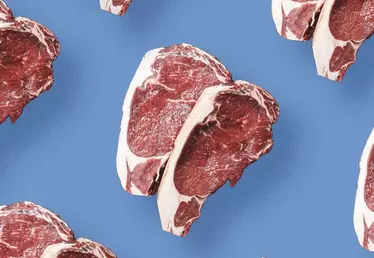

Hero banner custom title
What is the real cost of food waste?
10 min
On a global scale, the impact of food waste is significant economically, environmentally and humanly speaking.
An expired yoghurt thrown in the bin, fruit and vegetables left at the bottom of the fridge, a plate of leftovers disposed of, here and there... On a daily basis, these actions may seem harmless. But on a global scale, they amount to a vast amount of wasted food which could still be consumed. Nearly 17% of produced food ends up in household, retail, restaurant and other food service bins, according to a United Nations Environment Programme (UNEP) report published in March 2021. This is known as “food waste”. It amounts to no less than 931 million tonnes per year. This is the equivalent of 23 million 40-tonne lorries loaded to capacity, in a single file, i.e. seven times around the Earth! That is an average of 121 kilos of food wasted each year per consumer, of which more than half (61%) is wasted at home (the rest in restaurants or retail outlets).
A global scourge
A grim fact involving all countries, and not just the rich ones, contrary to popular belief. Nigeria is said to be the country with the highest food waste, with 189 kilos of food wasted per person each year, compared to 89 kilos in France, for example. “This waste can be due to many factors: excessive serving sizes, lack of planning, cooking skills, knowledge on storage, understanding of date labels etc.” explains Liz Goodwin, Director of Food Loss and Waste for the World Resources Institute (WRI), a US-based think tank on environmental issues.
931 millions
tonnes
That is the amount of food production wasted each year. The equivalent of 23 million 40-tonne lorries loaded to capacity, in single file, i.e. seven times around the Earth.
To “food waste” should be added “food loss”. This occurs in the supply chain, between food production and retailing. According to the Food and Agriculture Organisation (FAO), this affects 14 % of the food produced in the world (to which must be added a further 17% which will then be wasted). Such loss can be due, for example, to “poor harvesting and storage techniques, lack of cold chain infrastructure, poor road infrastructure and stock management etc. And this loss tends to be worse in developing countries”, notes Liz Goodwin.
However, it should be noted that the calculation methods differ from country to country. This makes it impossible to draw a direct comparison. In France, only the waste of solid food thrown in the bin is taken into account, whereas the British, for example, also measure what they throw down the sink (milk, soup, sauce etc.). It has therefore been difficult to assess progress accurately for a long time. But recently, the United Nations Environment Programme (UNEP) and the FAO have created a tool to do just that: a single calculation method. The first reports using the “food loss index” and “food waste index” were published in October 2019 and March 2021. States now have consistent and comparable data, and it is up to them to use it.
A human, environmental and economic cost
On a global level, food loss and waste are considerable. And the human, ecological and economic impact is massive. First of all, it is a social disaster, as 768 million people went hungry in 2020 (more than twice the population of the United States), and nearly 40% of humanity is unable to eat properly. But it is also an ecological aberration, at a time when the fight against climate change is paramount. Resources (water, agricultural land, etc.) have been wasted, and pollution and greenhouse gases have been generated for nothing. According to Liz Goodwin of the WRI, food loss and waste account for “8 to 10 % of global greenhouse gas emissions, a quarter of the water used in agriculture, and take up the equivalent of the size of China in agricultural land”. Lastly, the economic losses are enormous. “More than $1,000 billion every year. That's £700 (i.e. $974) a year for an average household with two children in the UK”, says Liz Goodwin. In 2017, Mexico wasted 491 billion pesos (about $24 million), or about 2.5% of gross domestic product, on food loss and waste.
"Food loss and waste account for 8 to 10 % of global greenhouse gas emissions, a quarter of the water used in agriculture, and take up the equivalent of the size of China in agricultural land."
Rethinking our relation to food
“We need to change our entire relation to food, says Eric Birlouez, a French sociologist in the field of food. We need to rediscover its vital and human character, for example by showing who produces it, by growing it ourselves, by adding this knowledge to that taught at school, by learning to cook, etc.” Although food waste is far from being a recent phenomenon, its extent has skyrocketed since the 30-year post-war boom: “The modernisation of agriculture and industry has made it possible to produce much more, at an ever lower price. However, we waste more of what we value less”, explains the sociologist. In this new consumer society, lifestyles have changed: “urbanisation has pushed consumers further away from producers, we no longer know how food is produced, we take less time to cook leftovers...” The marketing of large-scale distribution also encourages consumers to buy beyond their needs, through special deals, for example, and promotes fruit and vegetables that look perfect, at the risk of wasting.
In recent years, several countries have tried to tackle the problem. In France, the 2016 Garot law on food waste, for example, required supermarkets (and later the catering and food industry) to donate their unsold food to associations instead of destroying it, a world first! Raising the awareness of citizens and companies also allows for new initiatives. In Denmark, the Facebook group “Stop Spild Lokalt” allows individuals to donate their surplus food in 120 cities across the country. “We save 30 tonnes of produce every day”, explains Rasmus Erichsen, its founder. The Too Good To Go app, born in Copenhagen, allows shops to sell their unsold goods at low prices, and is now developing in some fifteen countries such as France, Spain, Poland, Canada and the United States.
“The modernisation of agriculture and industry has made it possible to produce much more, at an ever lower price. However, we waste more of what we value less”
In developing countries, better access to cold storage is one way to reduce food waste. In Kenya, the Solar Freeze start-up offers small-scale farmers the opportunity to store their crops in a solar-powered mobile fridge. In Ethiopia, the FAO is helping farmers install metal silos and use airtight bags to store grain. To combat food loss during transport, the same UN organisation has launched a project to distribute stackable and nestable plastic containers to improve the transport of fresh fruit and vegetables in several countries in South and South-East Asia. The UN, as part of its Sustainable Development Goals, hopes to halve food loss and waste by 2030.
Everyone has a role to play, at their own level. “Make a shopping list according to what you already have, use leftovers, store products better, for example, apples in the fridge spoil less quickly”, lists Liz Goodwin. You can also learn how to read expiry, use-by or best-before dates to better anticipate the end of life of your products, and above all avoid throwing away those that can still be consumed.
Share it:












